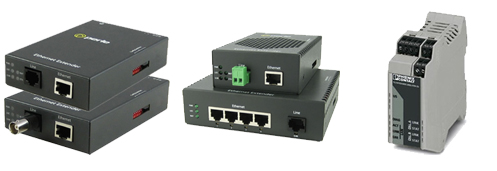Considerations when choosing an Ethernet Extender
Ethernet Extenders transparently extend 10/100/1000 Ethernet connections beyond 100m (328ft) -- the general maximum cable length for copper Ethernet cables, across single twisted pair ( CAT5/6/7 ), coax or any existing copper wiring previously used in alarm circuits, E1/T1 circuits, RS-232, RS-422, RS-485, CCTV and CATV applications. This ability to tap into unused wiring that was abandoned as systems were upgraded over the years is efficient and a huge budget saver. They allow 10/100Base-TX networks to ultize the power of SHDSL to transmit Ethernet data up to 20km [12.5 mi]. Or, VDSL technology can be used to extend 10/100/1000Base-T Ethernet up to 3km [2 mi].
Q1 - Does the manufacturer use chips from leading manufacturers?
A - If you choose a low-end Ethernet Extender, the end to end connection on your network will always appear as if it is up and running, even though the connection may be broken or disconnected. It is critical to ensure your Ethernet Extenders have an on-board microcontroller to deal with error detection and recovery by continuously monitoring the status of the links.
Q2 – What is the MTBF of the Ethernet Extender?
A - MTBF rates give insight into the quality of components used in the design and manufacture of the product. If the MTBF rates are high, you can have confidence that you will get a quality product made with quality components. If the MTBF rates are low, or unpublished, proceed with caution. Also, short warranty periods indicate a short life-span for the equipment.
Q3 – Is the chassis metal or plastic?
A - A rugged metal housing provides superior EMC performance and corrosion-resistance to fit in any environment. If you choose a product with a plastic chassis, inquire about the quality of plastic to ensure it meets commercial-grade standards.
Q4 – Are the industrial models built with temperature rated components that are fully heat chamber tested?
A - There are a lot of products on the market claiming to operate at -40°F to 167°F (-40°C to 75°C) but, they use “commercial-grade” components that have not been qualified to operate at the claimed temperature ranges. When “commercial-grade” parts are exposed to extremely high or low temperatures, product failures are inevitable. For example, integrated circuits on the PCB overheat causing premature failure of the product. Under-rated connectors do not allow for proper contact between the device and the cables. These failures eventually stop all data communications in these high and low-temperature environments.
Q5 – Does the PoE Ethernet Extender have a fully compliant IEEE 802.3af built-in PSE controller?
A - Almost all PoE Ethernet Extenders on the market operate as simple passive power injectors and always apply 44-57 volts of power to the RJ45 port pins. This results in severe damage to connected equipment if non-PoE compliant Ethernet devices are accidentally connected. This happens all too often by staff at remote sites resulting in thousands of dollars lost to equipment replacement. It is critical to ensure your chosen PoE Ethernet Extender has a fully compliant IEEE 802.3af built-in PSE controller that can tell, through signature detection, whether or not an attached Ethernet device is PoE capable.
Q6 – Can I remotely reset PoE devices?
A - Perle is the only manufacturer of Ethernet Extenders that support a unique feature -- Powered Device (PD) Reset -- enabling a central site administrator to reboot remote PoE devices.
Q7 – Does the Ethernet Extender support my exiting security protocols and authorization schemes?
A -In environments where network security is critical, the simple User ID / password implementation provided by some vendors is not enough. Only Ethernet Extenders that utilize the existing authorization schemes (TACACS+, RADIUS, LDAP, Kerberos, NIS, or RSA) in the enterprise should be deployed to ensure an audit trail is possible. To further protect IDs and passwords from someone ‘snooping’ on the network, you should also verify that secure management sessions are supported using SSH/SSL/TLS, SNMPv3, Telnet, and HTTPS. These features are used when managing corporate firewalls, switches, and routers. Therefore, it should be expected that they are available in a Managed Ethernet Extender.
